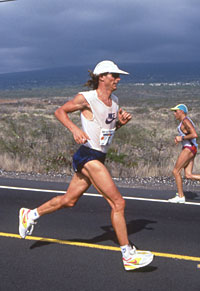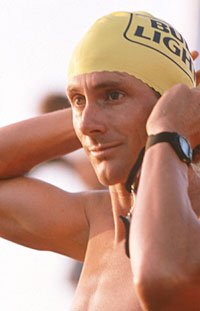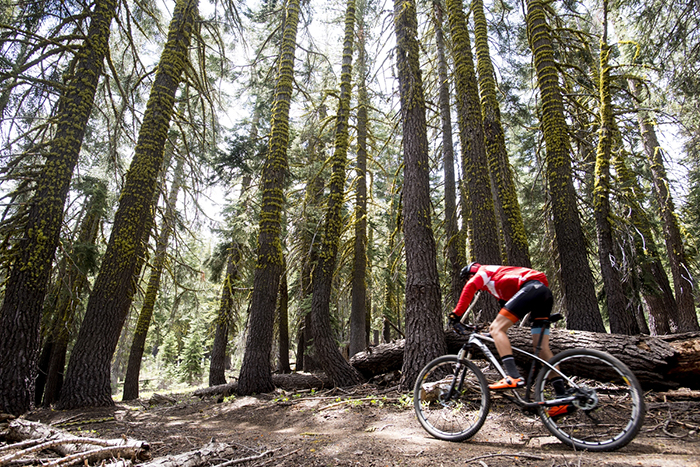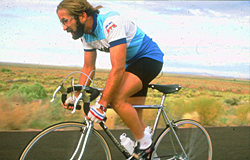- Tahoe’s Nevada Beach Tops the List of Hard-to-Book Campgrounds - 07/17/2024
- Cannabis Watershed Protection Program Cleans Up Illegal Grow Sites - 07/10/2024
- French Fire - 07/05/2024
By Mark Allen
 The weather is more inviting for outdoor training, daylight is extending its presence, and a lot of athletes are wondering
The weather is more inviting for outdoor training, daylight is extending its presence, and a lot of athletes are wondering
how to scrape off winter’s mold. No matter what sport you love to do most, there are a few keys that will help you take advantage of the extra sunshine to get back in shape in a way that will enable your fitness to progress through the rest of the year.
Build Your Aerobic Engine
The first of these tools is to build your aerobic fitness, which means the strength of your heart and your ability to burn fat for fuel. This is especially important for endurance athletes, but is something that will improve performance in just about any sport you engage in. The partner of this training is the anaerobic speed work that you will do later, after you have built your aerobic engine.
The early season is when your body, for a variety of reasons, needs to be given a steady diet of aerobic workouts. This means strap on the heart rate monitor and cool the jets a while longer. The fitness progress will be slower than maybe your ego would like it to be, but it will safeguard you from injury, illness, and motivational burn out. While physically, you’ll be less likely to feel flat later in the season.
The reason for this is that the maximum amount of time that most people can hold close to their top condition is only about 1-3 weeks. That’s right! So the best thing you can do if you are an eager speedster right now is to save that positive enthusiasm for the right time of the year. Cut out any kind of fast workouts that you are doing right now. Yes, all of them. Running fast in March or April is not going to last you until July or August.
Figure out what heart rate you can work out at and stay aerobic (fat burning) in the early season by using the following formula:
- Take 180
- Subtract your current age
Now take this number and make the following one correction that best describes your level of fitness:
- If you have or are recovering from a major illness or year-long
training-preventing injury, subtract 10. - If you are sedentary or do less than two days of working out a week, or if you have colds or flu every few weeks, subtract 5.
- If you have been working out three to four times per week for at least 30 minutes for a year or more, keep the number where it is.
- If for the past year you have consistently worked out four or more times per week for more than 30 minutes OR you workout a total of at least five hours a week, add 5.
Note: If you are over 55 years of age or under 25, take whatever number you have right now and add an additional 5 beats to it.
The number that you came up with has extreme significance in developing a sustainable body fitness program. This number is the heart rate that is the switch point between fat burning and carbohydrate burning. It is called your maximum aerobic heart rate.
If you are working out at a heart rate that is below this number, your body will be able to use fat as the main source of fuel and you will be developing your aerobic or fat burning system. If you are working out at a heart rate higher than this number your body will switch over and use carbohydrate as the main source of fuel and you will be developing your anaerobic or carbohydrate burning system.
Use this as your guide for all of your aerobic cardiovascular workouts now. Later in the season, when you get within a month or so of any competitions you might have, it will then be time to include speed sessions once or twice a week where you spend roughly 20 minutes somewhere between this number and your maximum heart rate. Usually a good ratio of aerobic training weeks to anaerobic training weeks is roughly 2-2.5:1. So if you spend 12 weeks doing base work, you will follow that with 5-6 weeks of speed work.

Strength
The early season is the best time of year to add the second tool to your overall program, which is strength training. Everyone from climbers to surfers to runners will do better with added strength. The catch to doing strength work is that while you are developing new muscular strength, your overall performance will be slightly below the level it would be without the weight training. However, once the main gains have been made in strength, your performance will be significantly higher than it would have been without adding this to your program.
The “how much” of strength training is something that could be debated for a very long time. In general, however, if you are training for a sport that is not primarily strength dependent, the amount of time in the gym that will give you the most benefit is twice a week. Pick 12 exercises that work all the major muscle groups, with a moderate emphasis on the primary ones you will use in your sport. Work the 12 exercises starting
with the large muscles and alternate between the front and the back of the body. Every six weeks you can alter some of the exercises and the number of sets and repetitions that you do. But in general two sets of 15 reps on each is all it takes to begin the early season muscle building.
Flexibility
The third and final focus during the early season should be on flexibility. Most people find that they have the stiffest muscles when they are in the process of getting in shape. Then, once training has become something your body is used to and expecting, the need for flexibility work actually decreases. The reason for this is that the relative increase between your training level from week to week is greater initially.
There are many programs that work well for increasing flexibility. Try to find one that is functional but not excessive. A certain amount of tension is needed in muscles to make them fire correctly. Too much flexibility can work counter to this. Stretching also increases inflammation in muscle tissue. So go at the flexibility work a few days per week. But just like anything, too much of a good thing can be to your detriment.
If you stretch on your own, make sure that you undertake it after workouts rather than before. Use your warm up in training to allow your muscles to gradually increase their length naturally. If you try to do this by stretching there is a risk of actually causing the muscle to shorten. This has to do with how muscles protect themselves from being over-stretched. However, if you stretch after a workout the muscles are like a heated, pliable plastic and you have a much better chance of increasing their length without overstretching.

The Basics Plus One
There you have the three basics to early season training: build your base, increase strength, and do flexibility work. To help keep your body and mind fresh, add in some early season short races or performance tests that you do at a higher intensity. You can do these once every 3-4 weeks. This will help bump your fitness up without the risk of peaking too early or the burn out that doing regular speed work can cause. Pick a competition that is relatively short (around an hour or less) that you can really go for it in. This will shock the system without doing harm to it, and serves as a great way to break up the steady aerobic training program you’ll be patiently following.
Make no doubt, though: patience has its rewards.
—–
Mark Allen is the six-time winner of the Ironman World Championship in Hawaii.
In 1997, he was pronounced “The World’s Fittest Man” by Outside magazine.
The stories of his long, pitfall-marked journey through pain and self doubt to finally triumph at the Ironman are the backdrop for speeches he gives to companies worldwide. For information about Mark’s speaking availability, please contact him
at 1-888-245-2002.
Mark also co-teaches a workshop titled Fit Body Fit Soul with Brant Secunda, a shaman, healer and ceremonial leader in the Huichol Indian tradition. In this unique workshop the themes of “sport” and “spirit” are explored and integrated to provide people a blueprint for fitness on all levels and for the healing of body, heart and spirit. For more information on the next Fit Body Fit Soul workshop please call The Dance of the Deer Foundation at 831-475-9560, or go to www.shamanism.com.
Based in Santa Cruz, Mark also has a state of the art online triathlon training program at www.markallenonline.com. On this site, you can receive fully customized training programs that last 12-20 weeks. Each training schedule is based on your fitness history, age and racing goals.













